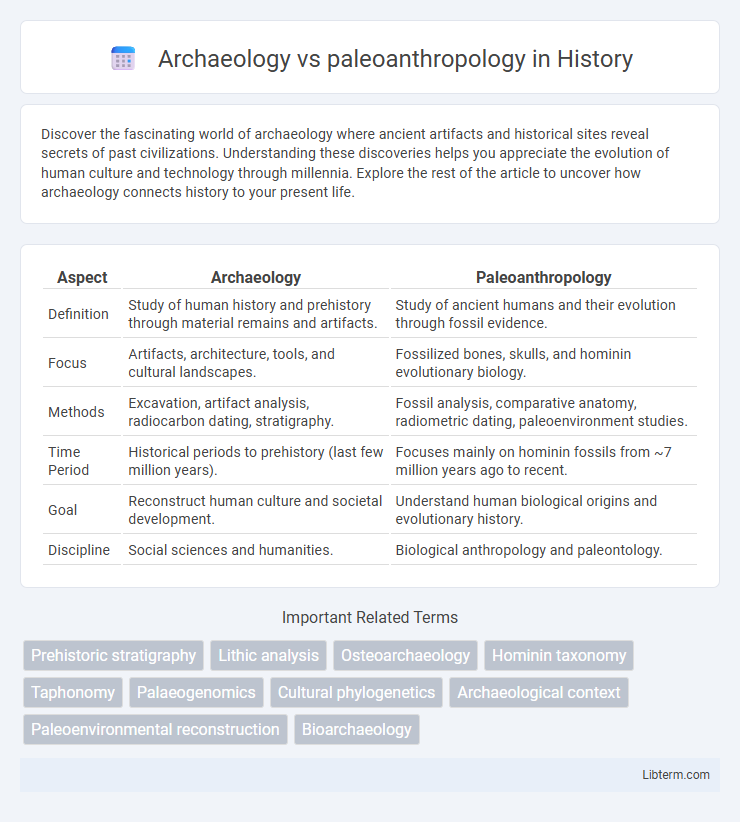Discover the fascinating world of archaeology where ancient artifacts and historical sites reveal secrets of past civilizations. Understanding these discoveries helps you appreciate the evolution of human culture and technology through millennia. Explore the rest of the article to uncover how archaeology connects history to your present life.
Table of Comparison
| Aspect | Archaeology | Paleoanthropology |
|---|---|---|
| Definition | Study of human history and prehistory through material remains and artifacts. | Study of ancient humans and their evolution through fossil evidence. |
| Focus | Artifacts, architecture, tools, and cultural landscapes. | Fossilized bones, skulls, and hominin evolutionary biology. |
| Methods | Excavation, artifact analysis, radiocarbon dating, stratigraphy. | Fossil analysis, comparative anatomy, radiometric dating, paleoenvironment studies. |
| Time Period | Historical periods to prehistory (last few million years). | Focuses mainly on hominin fossils from ~7 million years ago to recent. |
| Goal | Reconstruct human culture and societal development. | Understand human biological origins and evolutionary history. |
| Discipline | Social sciences and humanities. | Biological anthropology and paleontology. |
Introduction to Archaeology and Paleoanthropology
Archaeology studies human history and prehistory through material remains such as tools, pottery, and structures, revealing past cultures and societies. Paleoanthropology focuses on the biological and evolutionary aspects of ancient humans and their ancestors by analyzing fossils and skeletal remains. Both fields employ interdisciplinary methods but differ in emphasizing cultural artifacts versus biological evolution.
Defining Archaeology: Scope and Focus
Archaeology studies human history through material remains such as artifacts, architecture, and landscapes, focusing primarily on cultural and societal development from ancient to recent times. It investigates chronological contexts and technological advancements to reconstruct past human activities and social structures. Unlike paleoanthropology, which centers on human biological evolution and fossil analysis, archaeology emphasizes cultural artifacts and environmental interactions.
Understanding Paleoanthropology: Core Concepts
Paleoanthropology centers on the study of ancient human ancestors through fossil analysis, differentiating itself from archaeology by emphasizing evolutionary biology and morphological changes over time. Core concepts include hominid evolution, fossil dating techniques like radiometric methods, and the examination of skeletal remains to trace human ancestry and behavioral development. Understanding these concepts provides critical insights into the origins, adaptation, and diversification of early hominins in the broader context of human history.
Differences in Research Methods
Archaeology primarily employs excavation, stratigraphy, and artifact analysis to study human history and prehistory through material remains. Paleoanthropology focuses on fossil analysis, comparative anatomy, and dating techniques like radiometric dating to investigate human evolution and ancestral species. While archaeology interprets cultural and societal developments, paleoanthropology emphasizes biological and evolutionary aspects of ancient hominins.
Types of Evidence Collected
Archaeology primarily collects artifacts, architectural remains, and cultural landscapes that provide insights into human history and past societies. Paleoanthropology focuses on fossilized bones, teeth, and ancient DNA to study human evolutionary biology and ancestry. Both disciplines utilize stratigraphy and dating methods but target different types of evidence for reconstructing human pasts.
Major Discoveries in Archaeology
Major discoveries in archaeology include the excavation of ancient civilizations such as the Indus Valley, Mesopotamia, and ancient Egypt, revealing artifacts, architecture, and written records that provide insights into human history and culture. Notable finds like the Terracotta Army in China, Machu Picchu in Peru, and the Dead Sea Scrolls have significantly advanced the understanding of past societies. These discoveries differentiate archaeology from paleoanthropology, which primarily focuses on early human fossils and evolutionary biology rather than cultural artifacts.
Key Breakthroughs in Paleoanthropology
Key breakthroughs in paleoanthropology include the discovery of the Australopithecus afarensis specimen "Lucy," which provided critical evidence of bipedalism in early hominins dating back 3.2 million years. The sequencing of ancient DNA from Neanderthals and Denisovans has revolutionized understanding of human evolution and interbreeding events with Homo sapiens. Fossil finds such as the Homo naledi in South Africa challenge preconceptions about hominin diversity and brain size, expanding the timeline and complexity of human ancestry.
Academic Training and Disciplines
Archaeology emphasizes academic training in artifact analysis, excavation techniques, and cultural context interpretation, often rooted in anthropology, history, or classical studies departments. Paleoanthropology requires specialized training in human evolution, anatomy, and fossil analysis, typically integrated within biological anthropology or evolutionary biology programs. Both disciplines demand interdisciplinary skills, but paleoanthropology is more focused on evolutionary biology and physical anthropology, while archaeology centers on material culture and human behavior through time.
Overlapping Areas and Collaboration
Archaeology and paleoanthropology intersect in their study of human history through material remains and fossil evidence, respectively, enabling a comprehensive understanding of early human behavior and cultural evolution. Collaborative efforts involve integrating archaeological artifacts with paleoanthropological findings to reconstruct ancient environments and human adaptations. This interdisciplinary approach enriches insights into hominin development, technological innovation, and migration patterns across prehistoric periods.
Future Trends in Human History Studies
Future trends in human history studies emphasize interdisciplinary collaboration between archaeology and paleoanthropology, leveraging advances in DNA sequencing, remote sensing, and AI-driven data analysis to uncover deeper insights into early hominin behavior and migration patterns. Enhanced 3D imaging and virtual reconstruction technologies enable precise modeling of ancient sites and fossils, facilitating more accurate interpretations of cultural and biological evolution. Increasing integration of molecular anthropology with archaeological findings promises a comprehensive understanding of the human past, accelerating discoveries related to adaptation, environment interaction, and social complexity.
Archaeology Infographic

 libterm.com
libterm.com